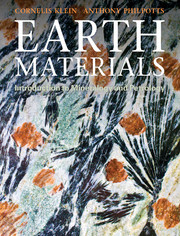Book contents
- Frontmatter
- Contents
- Preface
- Acknowledgments
- Chapter 1 Introduction
- Chapter 2 Materials of the solid Earth
- Chapter 3 How are minerals identified?
- Chapter 4 Fundamentals of crystal structures
- Chapter 5 Introduction to crystallography
- Chapter 6 Minerals and rocks observed under the polarizing optical microscope
- Chapter 7 Igneous rock-forming minerals
- Chapter 8 How do igneous rocks form?
- Chapter 9 Igneous rocks
- Chapter 10 Sedimentary rock-forming minerals and materials
- Chapter 11 Formation, transport, and lithification of sediment
- Chapter 12 Sedimentary rock classification, occurrence, and plate tectonic significance
- Chapter 13 Metamorphic rock-forming minerals
- Chapter 14 Metamorphic rocks
- Chapter 15 Some economic minerals, mainly from veins and pegmatites
- Chapter 16 Some selected Earth materials resources
- Chapter 17 Earth materials and human health
- Glossary
- Minerals and varieties
- Common igneous, sedimentary, and metamorphic rocks
- Index
- References
Chapter 11 - Formation, transport, and lithification of sediment
- Frontmatter
- Contents
- Preface
- Acknowledgments
- Chapter 1 Introduction
- Chapter 2 Materials of the solid Earth
- Chapter 3 How are minerals identified?
- Chapter 4 Fundamentals of crystal structures
- Chapter 5 Introduction to crystallography
- Chapter 6 Minerals and rocks observed under the polarizing optical microscope
- Chapter 7 Igneous rock-forming minerals
- Chapter 8 How do igneous rocks form?
- Chapter 9 Igneous rocks
- Chapter 10 Sedimentary rock-forming minerals and materials
- Chapter 11 Formation, transport, and lithification of sediment
- Chapter 12 Sedimentary rock classification, occurrence, and plate tectonic significance
- Chapter 13 Metamorphic rock-forming minerals
- Chapter 14 Metamorphic rocks
- Chapter 15 Some economic minerals, mainly from veins and pegmatites
- Chapter 16 Some selected Earth materials resources
- Chapter 17 Earth materials and human health
- Glossary
- Minerals and varieties
- Common igneous, sedimentary, and metamorphic rocks
- Index
- References
Summary
Importance of sediments in understanding the history of the Earth
Sedimentary rocks, which are the topic of Chapter 12, are formed by the accumulation and burial of sediment in depositional basins. Most sediment is formed from the weathering of preexisting rocks as a result of physical, chemical, and biological processes. Some sediment is formed directly by organisms, and some may be a direct chemical precipitate. Sedimentary rocks have a diverse compositional range, not only because of differences in the type and source of the sediment but also because of processes associated with the transport and burial of sediment. Before we discuss sedimentary rocks, we must, therefore, understand how sediment is formed, transported, deposited, and turned into rock (Fig. 11.1).
The formation of sediment, its transport, and deposition are dependent on topographic relief, which in large part is produced by plate tectonic processes. High relief at convergent and divergent plate boundaries promotes weathering and transport of sediment, so many sedimentary rocks are related to these regions.
When rocks weather, some minerals, such as quartz, remain stable, but most become unstable and are changed into new minerals characteristic of the weathering zone. Disintegration of the primary minerals is promoted by biological activity, with organisms feeding on the nutrients provided by the primary minerals. Because most of the weathering products of rock are silicate minerals, this type of sediment is referred to as siliciclastic sediment. It is the most abundant type of sediment, but sediment derived from organisms and chemical precipitates is also important.
- Type
- Chapter
- Information
- Earth MaterialsIntroduction to Mineralogy and Petrology, pp. 308 - 337Publisher: Cambridge University PressPrint publication year: 2012

